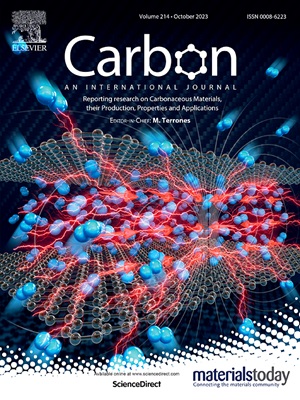Growing single-walled carbon nanotubes from alumina sheet supported catalyst and investigating carrier effects on chirality distribution
IF 10.5
2区 材料科学
Q1 CHEMISTRY, PHYSICAL
引用次数: 0
Abstract
Both the structure and type of support material significantly influence the performances of supported metal catalyst in synthesizing single-walled carbon nanotubes (SWNTs) through chemical vapor deposition. In this work, thin porous boehmite sheets prepared by hydrothermal method are applied as the precursor carriers for developing a supported iron catalyst. Upon high temperature calcination, the resulting alumina (α-Al2O3) and Fe2O3 form a solid solution, which catalyzes the growth of SWNTs at a low temperature of 700 °C. Detailed optical characterizations reveal that mainly subnanometer SWNTs with a narrow chirality distribution are synthesized. To explore the roles of catalyst support in catalysis, a magnesia (MgO) supported Fe catalyst is also designed. The MgO supported catalyst achieves an even narrower chirality distribution compared to the alumina-supported counterpart. By combining experimental catalyst characterizations with theoretical calculations, the SWNT chirality distribution is revealed to be highly sensitive to the surface basicity of the support materials. The strong basicity of the MgO facilitates electron transfer to the supported Fe nanoparticles, enhancing the adsorption and dissociation of the carbon precursor. This interaction ultimately promotes the nucleation of SWNTs by a perpendicular model.

氧化铝片负载型催化剂制备单壁碳纳米管及其载体对手性分布的影响
化学气相沉积法合成单壁碳纳米管时,载体材料的结构和类型对载体金属催化剂的性能有显著影响。本研究以水热法制备薄多孔薄铝水铝板为前驱体载体,制备负载型铁催化剂。经过高温煅烧,得到的氧化铝(α-Al2O3)和Fe2O3形成固溶体,在700℃的低温下催化swcnts的生长。详细的光学表征表明,合成的主要是具有窄手性分布的亚纳米单壁碳纳米管。为了探索催化剂载体在催化中的作用,设计了氧化镁(MgO)负载铁催化剂。与氧化铝负载的催化剂相比,MgO负载的催化剂实现了更窄的手性分布。通过实验表征和理论计算相结合,揭示了SWNT手性分布对载体材料表面碱度的高度敏感。MgO的强碱性有利于电子转移到负载的Fe纳米颗粒上,促进了碳前驱体的吸附和解离。这种相互作用最终通过垂直模型促进了单壁碳纳米管的成核。
本文章由计算机程序翻译,如有差异,请以英文原文为准。
求助全文
约1分钟内获得全文
求助全文
来源期刊

Carbon
工程技术-材料科学:综合
CiteScore
20.80
自引率
7.30%
发文量
0
审稿时长
23 days
期刊介绍:
The journal Carbon is an international multidisciplinary forum for communicating scientific advances in the field of carbon materials. It reports new findings related to the formation, structure, properties, behaviors, and technological applications of carbons. Carbons are a broad class of ordered or disordered solid phases composed primarily of elemental carbon, including but not limited to carbon black, carbon fibers and filaments, carbon nanotubes, diamond and diamond-like carbon, fullerenes, glassy carbon, graphite, graphene, graphene-oxide, porous carbons, pyrolytic carbon, and other sp2 and non-sp2 hybridized carbon systems. Carbon is the companion title to the open access journal Carbon Trends. Relevant application areas for carbon materials include biology and medicine, catalysis, electronic, optoelectronic, spintronic, high-frequency, and photonic devices, energy storage and conversion systems, environmental applications and water treatment, smart materials and systems, and structural and thermal applications.
 求助内容:
求助内容: 应助结果提醒方式:
应助结果提醒方式:


